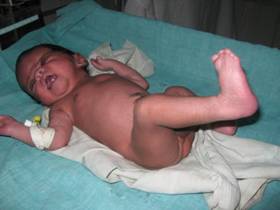Apert syndrome: A Case report
Keywords:
Apert syndrome, Brachycephaly, Syndactyly, Synonychia
Abstract
Apert syndrome or Acrocephalosyndactyly is a rare congenital disorder that affects the craniofacial structures and the limbs and is characterized by bicoronal synostosis, midface hypoplasia and complex syndactyly of the hands and feet. We report a neonate who had clinical and radiological features consistent with Apert syndrome.
Downloads
Download data is not yet available.
References
1. Cohen MM Jr, Kreiborg S. A clinical study of the craniofacial features in Apert syndrome. Int J Oral Maxillofac Surg.1996 Feb; 25(1):45-53. [PubMed]
2. Cunningham ML, Seto ML, Ratisoontorn C, Heike CL, Hing AV. Syndromic craniosynostosis: from history to hydrogen bonds. Orthod Craniofac Res.2OO7 May; 10(2):67-81. [PubMed]
3. Park WJ, Theda C, Maestri NE, Meyers GA, Fryburg JS, Dufresne C. Analysis of phenotypic features and FGFR2 mutations in Apert syndrome. Am J Hum Genet.1995 Aug; 57(2):321-8. [PubMed]
4. Chang CC, Tsai FJ, Tsai HD, Tsai CH, Hseih YY, Lee CC. Prenatal diagnosis of Apert syndrome. Prenat Diagn.1998 Jun; 18(6):621-5. [PubMed]
5. Cohen MM Jr, Kreiborg S. An updated pediatric perspective on the Apert syndrome. Am J Dis Child. 1993;147:989-93. [PubMed]
6. Wilkie AO, Wall SA. Craniosynostosis: novel insights into the pathogenesis and treatment. Curr Opin Neurol.1996;9:146-52. [PubMed]
7. Chen L, Li D, Li C, Engel A, Deng CX. Ser250trp substitution in mouse fibroblast growth factor receptor 2 (FGFR2) results in craniosynostosis. Bone.2003;33:169-78. [PubMed]
8. Wilkie AO, Slaney SF, Oldridge M, Poole MO. Apert syndrome results from localized mutation of FGFR2 and is allelic with Crouzon syndrome. Nat Genet.1995;9:165-72. [PubMed]
9. Glaser RL, Broman KW, Schulman RL. The paternal-age effect in Apert syndrome is due, in part, to the increased frequency of mutations in sperm. Am J Hum Genet. 2003; 73:939-47. [PubMed]
10. Cohen MM Jr, Kreiborg S. New indirect method for estimating the birth prevalence of the Apert’s syndrome. Int J Oral Maxillofac Surg.1992; 21:107-9. [PubMed]
11. Arroyo Carrera I, Martínez-Frías ML, Marco Pérez JJ. Apert syndrome: clinico-epidemiological analysis of a series of consecutive cases in Spain. An Esp Pediatr.1999; 51:667-72. [PubMed]
12. Kaplan LC. Clinical assessment and multispecialty management of Apert syndrome. Clin Plast Surg.1991; 18:217-25. [PubMed]
13. Renier D, Lajeunie E, Arnaud E, Marchac D.Management of craniosynostosis. Childs Nerv Syst. 2000 Nov; 16(10-11):645-58.
2. Cunningham ML, Seto ML, Ratisoontorn C, Heike CL, Hing AV. Syndromic craniosynostosis: from history to hydrogen bonds. Orthod Craniofac Res.2OO7 May; 10(2):67-81. [PubMed]
3. Park WJ, Theda C, Maestri NE, Meyers GA, Fryburg JS, Dufresne C. Analysis of phenotypic features and FGFR2 mutations in Apert syndrome. Am J Hum Genet.1995 Aug; 57(2):321-8. [PubMed]
4. Chang CC, Tsai FJ, Tsai HD, Tsai CH, Hseih YY, Lee CC. Prenatal diagnosis of Apert syndrome. Prenat Diagn.1998 Jun; 18(6):621-5. [PubMed]
5. Cohen MM Jr, Kreiborg S. An updated pediatric perspective on the Apert syndrome. Am J Dis Child. 1993;147:989-93. [PubMed]
6. Wilkie AO, Wall SA. Craniosynostosis: novel insights into the pathogenesis and treatment. Curr Opin Neurol.1996;9:146-52. [PubMed]
7. Chen L, Li D, Li C, Engel A, Deng CX. Ser250trp substitution in mouse fibroblast growth factor receptor 2 (FGFR2) results in craniosynostosis. Bone.2003;33:169-78. [PubMed]
8. Wilkie AO, Slaney SF, Oldridge M, Poole MO. Apert syndrome results from localized mutation of FGFR2 and is allelic with Crouzon syndrome. Nat Genet.1995;9:165-72. [PubMed]
9. Glaser RL, Broman KW, Schulman RL. The paternal-age effect in Apert syndrome is due, in part, to the increased frequency of mutations in sperm. Am J Hum Genet. 2003; 73:939-47. [PubMed]
10. Cohen MM Jr, Kreiborg S. New indirect method for estimating the birth prevalence of the Apert’s syndrome. Int J Oral Maxillofac Surg.1992; 21:107-9. [PubMed]
11. Arroyo Carrera I, Martínez-Frías ML, Marco Pérez JJ. Apert syndrome: clinico-epidemiological analysis of a series of consecutive cases in Spain. An Esp Pediatr.1999; 51:667-72. [PubMed]
12. Kaplan LC. Clinical assessment and multispecialty management of Apert syndrome. Clin Plast Surg.1991; 18:217-25. [PubMed]
13. Renier D, Lajeunie E, Arnaud E, Marchac D.Management of craniosynostosis. Childs Nerv Syst. 2000 Nov; 16(10-11):645-58.

CITATION
DOI: 10.17511/ijmrr.2014.i01.11
Published: 2014-02-28
How to Cite
1.
Kosam A, Nahrel R. Apert syndrome: A Case report. Int J Med Res Rev [Internet]. 2014Feb.28 [cited 2025Sep.14];2(1):63-6. Available from: https://ijmrr.medresearch.in/index.php/ijmrr/article/view/59
Section
Case Report


 OAI - Open Archives Initiative
OAI - Open Archives Initiative


